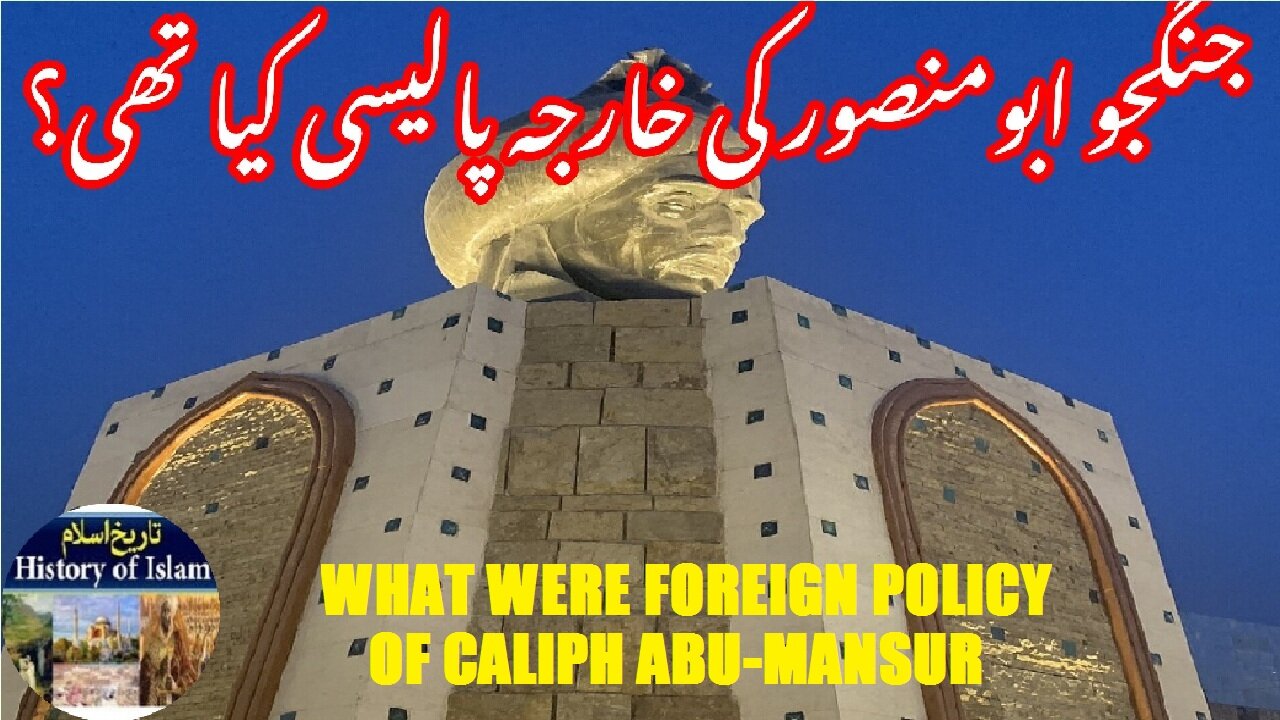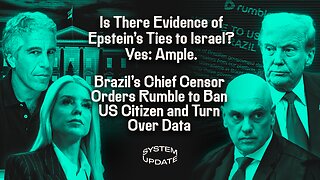Premium Only Content

What were Foreign policy of Caliph Abu-Mansur | خلیفہ ابو منصور کی خارجہ پالیسی کیا تھی؟
@islamichistory813 #AbuMansur #Diplomacy #HistoricalAnalysis #Foreign #policy #Caliph #AbuMansur
What were Foreign policy of Caliph Abu-Mansur
Dekhti Aankhooon aur sountay kaanoon ko Asslamoalaikum, sisters, brothers friends and elders,In this Islamic informative video, we are describing the foreign policy of Caliph Abu-Mansur, highlighting his approach to diplomacy and conflict during his rule. Through a detailed analysis of his interactions with neighboring states and the strategic decisions he made, we aim to provide a comprehensive understanding of his influence on the Islamic world. Describing how Abu-Mansur's foreign policy initiatives contributed to the expansion and stability of the empire.
In 751 the first Abbasid caliph al-Saffah had defeated the Chinese Tang dynasty in the Battle of Talas. Chinese sources record that al-Mansur sent his diplomatic delegations regularly to China. Al-Mansur's delegations were known in China as Heiyi Dashi (Black Clothed Arabs). In 756 al-Mansur sent 3,000 mercenaries to assist Emperor Suzong of Tang in the An Lushan rebellion. A massacre of foreign Arab and Persian Muslim merchants by former Yan rebel general Tian Shengong happened during the An Lushan rebellion in the Yangzhou massacre (760),
The Byzantine emperor Constantine V had used the weakness of the Umayyad caliphate to regain land from Muslim rulers. After the Umayyad caliphate was defeated by al-Mansur's predecessor al-Saffah, Constantine V invaded Armenia and occupied parts of it throughout 751 and 752. Under al-Mansur's rule Muslim armies conducted raids on Byzantine territory. Al-Mansur was the first Abbasid caliph to hold a ransom meeting with the Byzantine Empire. Diplomats in the service of Constantine V and al-Mansur first negotiated the exchange of prisoners in 756.
In 763 al-Mansur sent his troops to conquer al-Andalus for the Abbasid empire. But the Umayyad caliph Abd al-Rahman I successfully defended his territory. Al-Mansur withdrew and thereafter focused his troops of holding the eastern part of his empire on lands that were once part of Persia.
Some historians credit al-Mansur with starting the Abbasid–Carolingian alliance. In fact, it was the first Carolingian king Pippin III who initiated a new era of Franconian diplomacy by sending diplomatic envoys to al-Mansur's Baghdad court in 765. It is probable that Pippin III sought an alliance with al-Mansur against their common enemies, the Emirate of Córdoba. In 768 the envoys of Pippin III returned to Francia along with caliph al-Mansur's ambassadors. Pippin III received al-Mansur's delegation in Aquitaine and gifts were exchanged as a sign of the new alliance. This alliance was solidified when between 797 and 807 king Charlemagne and caliph Harun al-Rashid established embassies.
Al-Mansur's treatment of his Christian subjects was severe; he "collected from them capitation with much vigor and impressed upon them marks of slavery."
Al-Mansur's first wife was Arwa known as Umm Musa, whose lineage went back to the kings of Himyar. Her father was Mansur al-Himyari. She had a brother named Yazid. She had two sons, Muhammad (future Caliph al-Mahdi) and Ja'far. She died in 764. Another wife was Hammadah. Her father was Isa,[47] one of al-Mansur's uncles. She died during al-Mansur's caliphate. Another wife was Fatimah. Her father was Muhammad, one of the descendants of Talhah ibn Ubaydullah. She had three sons, Sulayman, Isa, and Ya'qub. One of his concubines was a Kurdish woman. She was the mother of al-Mansur's son Ja'far 'Ibn al-Kurdiyyah' (Nasab translating to "Son of the Kurdish woman"). Unlike his other adult half-brothers, little is known of Ja'far and he likely was not involved in politics or had marriage or issue. However, his death is recorded at 802 AD by palace records suggesting he lived into adulthood and continued to live at court rather than having been banished or dying before adulthood. Another concubine was Qali-al Farrashah. She was a Greek, and was the mother of al-Mansur's son Salih al-Miskin. Another concubine was Umm al-Qasim, whose son al-Qasim died at aged ten.[46] Al-Masnur's only daughter Aliyah was born to an Umayyad woman. She married Ishaq ibn Sulayman.
Al-Mas'udi writes that Mansur died on Saturday 6, Dhu al-Hijja 158 AH/775 CE. There are varying accounts of the location and circumstances of al-Mansur's death. One account narrates that al-Mansur was on a pilgrimage to Mecca and had nearly reached, when death overtook him at a location called the Garden of the Bani Amir on the high road to Iraq at the age of sixty-three. According to this narration, he was buried in Mecca with his face uncovered because he was wearing the ihram clothing. 100 graves were dug around Mecca with the intention to thwart any attempt to find and violate his bones.
A different narration from Fadl ibn Rabi'ah, who claimed to have been with Mansur at his time of death, states that he died at al-Batha' near the Well of Maimun in which he would have been buried at al-Hajun at sixty-five years of age. In this narration, Mansur was sitting in a domed room hallucinating about ill-omen writings on the wall. When al-Rabiah replied "I see nothing written on the wall. Its surface is clean and white," al-Mansur replied, "my soul is warned that she may prepare for her near departure." After reaching the Well of Maimun, he reportedly said "God be praised" and succumbed to death that very day.
When al-Mansur died, the caliphate's treasury contained 600,000,000 dirhams and fourteen million dinars. On his deathbed, Mansur said, “We have sacrificed the life to come for a mere dream!
Tomorow we will be described Biography of Warrior and third Abbasid Caliph Al-Mahdi. So permission us upto tomorow. Allah Hafiz
=========================================
-
 9:03
9:03
ISLAMIC HISTORY
1 day agoIslamic History Episode 163 The Khawarij and your death ख़वारिज और आपकी मौत خوارج اور آپکی وفات
10 -
 8:01
8:01
MattMorseTV
11 hours ago $5.66 earnedTrump just DROPPED a BOMBSHELL.
42.8K51 -
 LIVE
LIVE
Cancel This Podcast
6 hours ago $0.57 earnedROLE-PLAYING GRINDS: FINAL FANTASY XIV, DRAGON QUEST X & OCTOPATH COTC - CTP GAMING MONDAYS!
334 watching -
 7:25:37
7:25:37
FoeDubb
7 hours ago🏰KINGDOM MENU :🎮LATE NITE PUBG 🤣MOST LIKELY A BAD IDEA DILLY DILLY!!!
11.2K -
 1:34:52
1:34:52
Glenn Greenwald
9 hours agoIs There Evidence of Epstein's Ties to Israel? Yes: Ample. Brazil's Chief Censor Orders Rumble to Ban US Citizen and Turn Over Data | SYSTEM UPDATE #486
151K130 -
 2:20:40
2:20:40
GamerGril
3 hours agoMarvel Rivals Monday | Battle Of The Bronze
10.6K3 -
 46:08
46:08
FanatikGaming
2 hours ago $0.71 earned💪Monday Motivation🦾 - Legends Never DIE!💯💯 ATWU - BTTB!☝️🔥
14.8K2 -
 LIVE
LIVE
WolfLinksShadow
3 hours agoMario Kart Monday & More!
193 watching -
 58:16
58:16
Redacted News
12 hours agoThe Secret Space Program IS REAL and this Whistleblower is EXPOSING all of it
79K263 -
 3:37:54
3:37:54
This is the Ray Gaming
4 hours ago $0.44 earnedHead Shots and Heart Breaks | Rumble Premium Creator
11.4K1